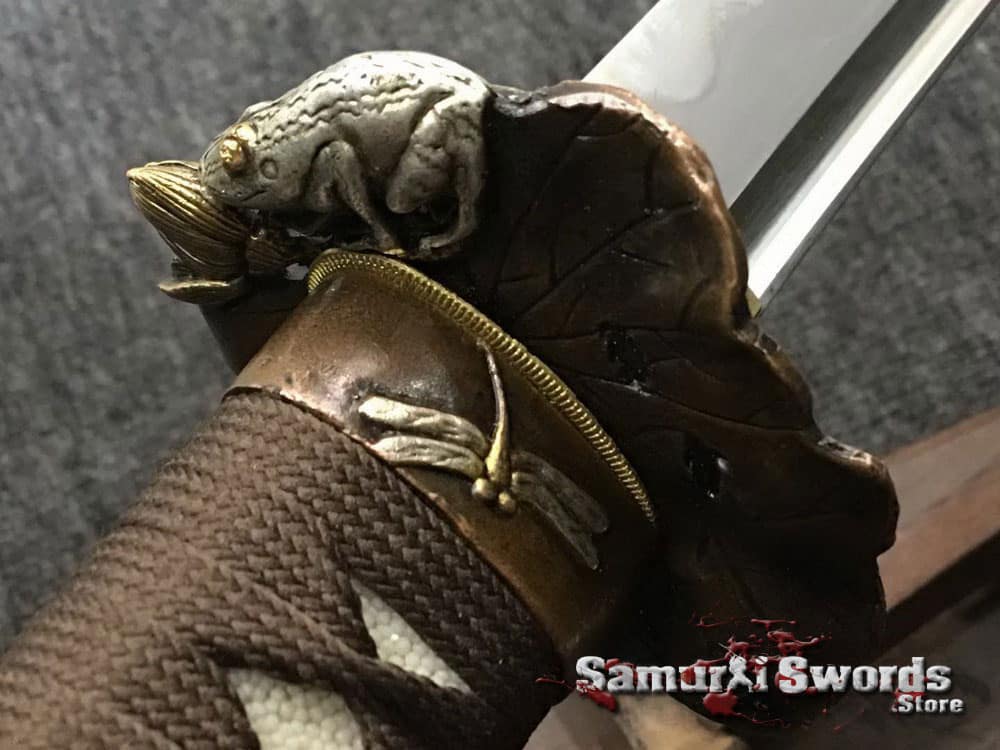Tactical Katana T10 Folded Clay Tempered Steel with Feather Hadori Polish
This Tactical Katana is made of T10 Folded Clay Tempered Steel with Feather Hadori Polish and featuering Blue And Gold Saya with High Quality Copper Fittings
Sword Type: Katana
Steel Type: T10 Folded Clay Tempered Steel Feather Hadori Polish
Blade Length: 72 Centimeters
Handle Length: 27 Centimeters
Blade Width: 3.2 Centimeters
Weight: 1.68KG
Tang: Full Tang
Sharpness: Sharpened
Blood Groove: With Bohi (Blood Groove)
Tsuba (Handguard): High Quality Copper Tsuba
Fuchi (Hilt Collar): High Quality Copper Fuchi
Kashira (Pommel): High Quality Copper Kashira
Menuki (Handle Ornaments): High Quality Copper Menuki
Saya (Scabbard): Blue And Gold Saya
Ito (Wrap): Brown
Ray Skin (Samegawa): White
Sword Bag: Silk
This sword is a Katana made of T10 folded, clay tempered steel, and is feather Hadori polished. Its blade has a length of 72 centimeters and its width is 3.2 centimeters. Its Tsuka measures 27 centimeters long and weighs a total of 1.68 kilograms.
Folded, Clay Tempered, and Polished Blade
T10 steel is one of the toughest carbon steel types around. Its properties aren’t only great for tools, but is efficient for sword crafting as well.
This Katana has subtle Hada due to folding. These are grain patterns on the blade’s surface to increase its artistic quality. Having Hada on the sword does not affect its performance or its hardness. The blade is also Hadori polished to increase the beauty of the Hamon.
It is a Katana with a clay tempered blade. This is something achieved by setting a wet clay compound to the blades edge and spine. An advantage of this is that the sword becomes more durable and resistant.
Durability, Toughness, and Swiftness
The Japanese Katana is excellent for cutting practice, Tameshigiri, or Iaido. This is because of it being fully sharpened. Since it is a full tang piece, the Katana allows for increased leverage through the Tsuka. This is an advantage when the Katana is often used against harder objects.
This sword also sports a Bohi, also known as the fuller or blood groove. It is a narrow and long indention running down the blades length. The Bohi functions by making the sword lighter and easier to wield.
Adornments and Components
This tactical Katana has a collection of Tosogu or fittings made from high quality copper. These are the Kashira, Menuki, Fuchi, and Tsuba.
For the Tsuka, it’s wrapped with a brown Ito that has functional and aesthetic purposes. It prevents technical failure while also keeping your hands from slipping during practice.
Underneath the Ito is a white Samegawa. It is rayskin used to wrap the Tsuka, and to keep the Ito in place. What it also does is it encourages a better grip.
If you like to change any of the sword aspects, steel, handle or fitting, you can customize your own Katana by visiting this link.
The Saya
This Katana comes with a blue and gold Saya that adds more beauty to the piece. Aside from beauty, it also protects the blade from dust and dirt. In addition, the Katana comes with a silk sword bag. This is necessary when you carry and transport the sword for practice.
A Staple Pair, The Daisho
In ancient Japan, the Katana was paired with a smaller blade. It was often matched with a Wakizashi in a pair called the Daisho. Sometimes, it could be with a Tanto, or a similar shaped dagger.
The Daisho was only specific to the Samurai class. This is because it showed their personal honor and social power.
Based on the classic schools of Kenjutsu, one blade in the Daisho was only used for battle. Yet in the 1st half of the 17th century, things have changed. The famous Samurai, Miyamoto Musashi, promoted using the single-handed grip. This allowed you to use two blades simultaneously.
The technique is the Nito Ken, a main element of the Niten Ichi Ryu. It was a style developed by Musashi himself.

